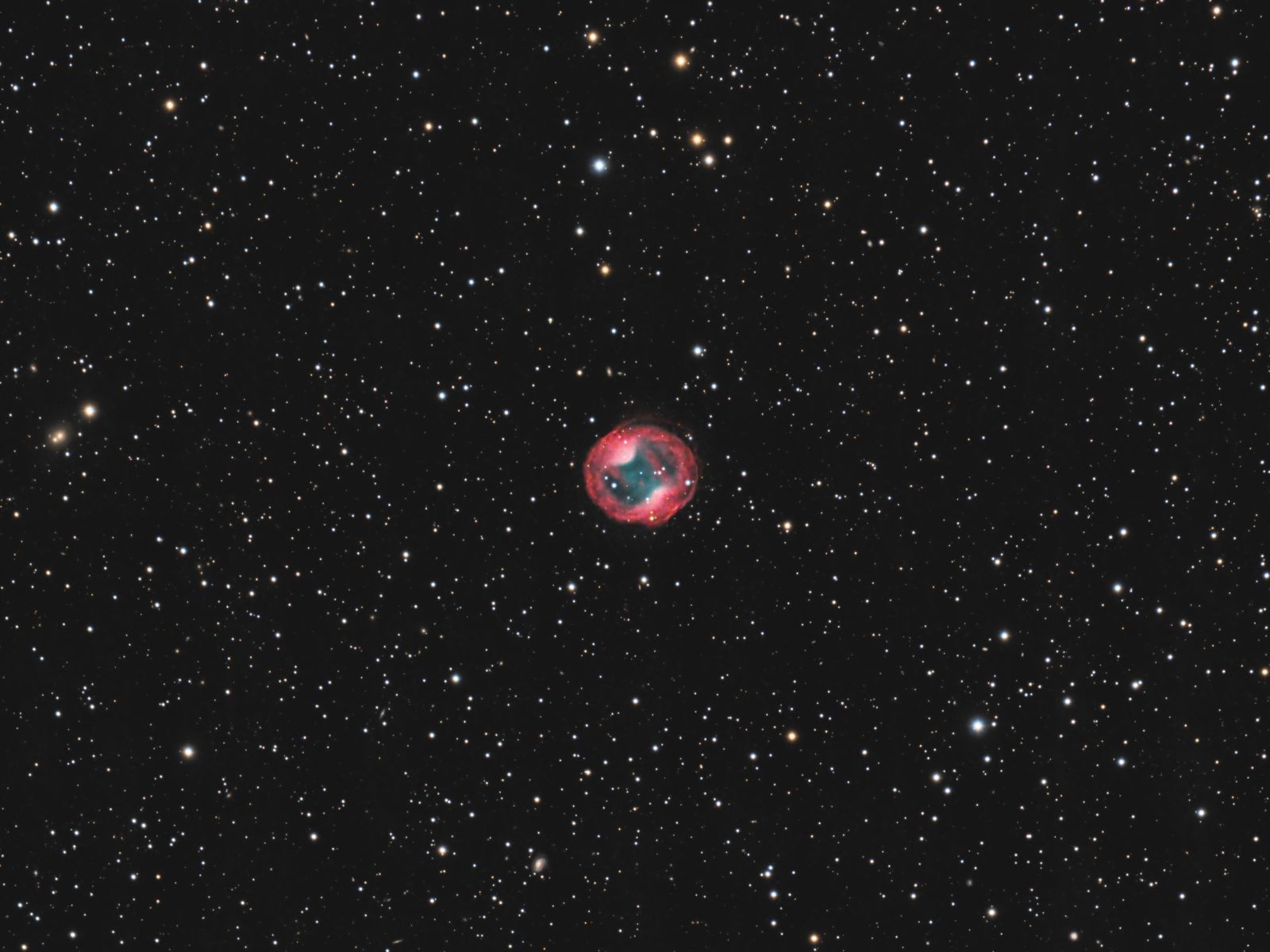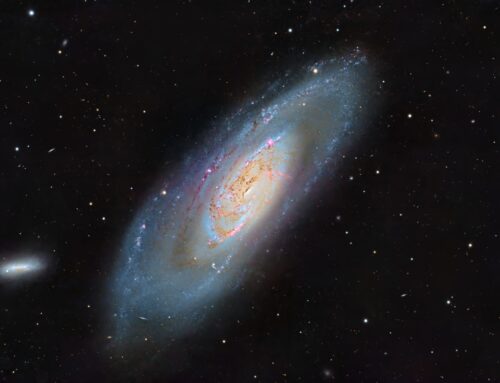Jones-Emberson 1
 Click image for full size version
Click image for full size version
May 5, 2021; Amateur Astronomy Photo of the Day, May 16, 2021
Jones-Emberson 1, a.k.a the Headphone Nebula, is a northern planetary nebula. It is also catalogued as PK 164+31.1. It is located about 1600 light years away in Lynx. The red and green glows are mainly due to emissions from hydrogen and oxygen atoms, respectively. The nebula’s brightness is listed as magnitude 14.1, but it is relatively large, so the light is spread out and it has a very low surface brightness.
This image includes galaxies that lie millions of light years away, thousands of times further away than the nebula. Look for streaks and smudges that look obviously different from the sharper, rounder stars.
Tekkies:
Acquisition, focusing, guiding and control of Paramount MX mount with TheSkyX. Focus with Optec DirectSync motor and controller. Automation with CCDCommander. Equipment control with PrimaLuce Labs Eagle 3 Pro computer. All pre-processing and processing in PixInsight. Acquired from my SkyShed in Guelph. Minimal moonlight, above average transparency and average or better seeing. Data acquired March 21-April 13, 2021.
Luminance and Narrowband: Sky-Watcher Esprit 150 f/7 refractor and QHY 16200-A camera with Optolong UV/IR, Ha and O3 filters
Chrominance: Takahashi FSQ-106 ED IV @ f/3.6 and QHY367C Pro one-shot colour camera with Optolong UV/IR filter
Narrowband:
Total: 31hr55m
Data Reduction and Processing
Preprocessing: The WeightedBatchPreProcessing script was used to create Luminance, Ha and O3 master frames (from the mono camera) and a RGB master frame (from the one-shot colour camera). The colour master was integrated with DrizzleIntegration.
Gradient Removal: DBE was applied to each master using Subtraction to remove the gradients that remained after integration.
Colour
Colour Balancing: Colour was balanced with ColorCalibration.
Linear Noise Reduction: MultiscaleLinearTransform was used to reduce noise in the background areas, using an internal mask to protect bright structures. Layer settings for threshold and strength: Layer 1: 5.0 0.85, 2 iterations; Layer 2: 3.5, 0.75, 2 iterations; Layer 3: 3.0, 0.5, 1 iteration; Layer 4: 1.0, 0.25, 1 iteration.
Stretching: HistogramTransformation was applied to make a pleasing, bright image, with background set to an intensity of approximately 0.10.
Lightness, Ha and O3
Deconvolution of Ha: StarMask was applied to the Ha master with default settings to produce a Local Deringing Support Image. A clone of the image was stretched to use as a deconvolution mask. Deconvolution was applied (100 iterations, regularized Richardson-Lucy, external PSF made using PSFImage script with about 50 stars).
Linear Noise Reduction: MultiscaleLinearTransform was used to reduce noise in the background areas of each master (L, Ha and O3), using an internal mask to protect bright stars. Layer settings for threshold and strength for Lightness: Layer 1: 3.0 0.85, 1 iterations; Layer 2: 2.0, 0.75, 1 iterations; Layer 3: 1.0, 0.5, 1 iteration. Adjustments were made to the internal mask and settings for the narrowband masters.
Stretching: HistogramTransformation was applied to make a pleasing, bright image from each master, with background set to an intensity of approximately 0.10.
Combining Lightness and Colour Images
Registration of L and RGB: DynamicAlignment was used to register the RGB master to the L master.
LRGB Combination: The lightness image was applied to the RGB image using LRGBCombination with default settings.
Additional Processing and Addition of Narrowband
Nonlinear Noise Reduction: TGVDenoise was used in L*a*b* mode to reduce noise with a mask used to target the background areas and protect the stars (max. 1000 iterations and convergence selected for both lightness and chrominance).
Contrast Enhancement: LocalHistogramEqualization was applied twice (scale of 20 with strength 0.35; then scale of 40 with strength 0.25) using a mask to protect stars and low-signal regions of the image.
Sharpening: The nebula was sharpened with a pass of MultiscaleLinearTransform (bias +0.15 on 2nd and 3rd layers and dark deringing = 0.05).
Addition of Ha and O3 to Nebula: The narrowband masters were blended into the nebula using PixelMath with masks to protect the rest of the image.
Final Steps: Nebula, background and star brightness, contrast, hue and colour saturation were adjusted in several iterations using CurvesTransformation with masks as required. MorphologicalTransformation was used in Morphological Selection mode (Strength 0.8; Selection 0.13) through a star mask to shrink the brightest stars. ICCProfileTransformation (sRGB IEC61966-2.1; Relative Colorimetric with black point compensation) was applied prior to saving in jpg format.






Stunning! Yet another fabulous image and background to how this was captured..great job Ron! 🎧